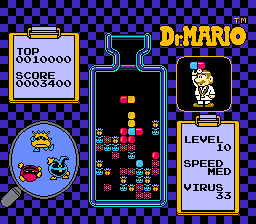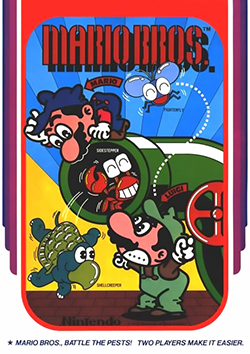
Mario Bros. is a platform game developed and published by Nintendo as an arcade video game in 1983. It was designed by Shigeru Miyamoto and Gunpei Yokoi, Nintendo's chief engineer. Italian twin brother plumbers Mario and Luigi exterminate creatures, like turtles (Koopas) and crabs emerging from the sewers by knocking them upside-down and kicking them away. The Famicom/Nintendo Entertainment System version is the first game produced by Intelligent Systems. It is part of the Mario franchise, but originally began as a spin-off from the Donkey Kong series.
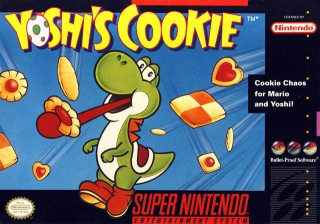
Yoshi's Cookie is a 1992 tile-matching puzzle video game developed by Tose and published by Nintendo for the NES and Game Boy platforms in 1992. A Super NES version was released the following year, developed and published by Bullet-Proof Software.

Tetris Attack, also known as Panel de Pon in Japan, is a puzzle video game developed by Intelligent Systems and published by Nintendo for the Super Nintendo Entertainment System. A Game Boy version was released a year later. In the game, the player must arrange matching colored blocks in vertical or horizontal rows to clear them. The blocks steadily rise towards the top of the playfield, with new blocks being added at the bottom. Several gameplay modes are present, including a time attack and multiplayer mode.

Gunpei Yokoi, sometimes transliterated as Gumpei Yokoi, was a Japanese toy maker and video game designer. As a long-time Nintendo employee, he was best known as creator of the Game & Watch handheld system, inventor of the cross-shaped Control Pad, the original designer of the Game Boy, and producer of a few long-running and critically acclaimed video game franchises such as Metroid and Kid Icarus.

Wario's Woods is a puzzle video game developed and published by Nintendo. It was released in Japan and North America in 1994 and Europe in 1995 for both the Nintendo Entertainment System and the Super Nintendo Entertainment System. A spin-off of the Mario series, players control Toad in his mission to defeat Wario, who has taken control of the Peaceful Woods. Gameplay revolves around clearing each level by using bombs to destroy groups of enemies. The game also features a multiplayer mode that allows two players to compete against each other.

Ice Climber is a platform game developed and published by Nintendo. It was released in 1985 for both the arcade VS. System and the Famicom / Nintendo Entertainment System console. The characters Popo and Nana, collectively known as the Ice Climbers, scale 32 vertically scrolling, ice-covered mountains to recover stolen vegetables from a giant condor. In some European countries, Ice Climber was bundled with the Nintendo Entertainment System.
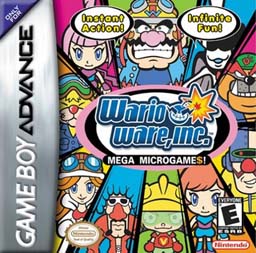
WarioWare, Inc.: Mega Microgames!,, known as WarioWare, Inc.: Minigame Mania in the PAL region, is a minigame compilation video game developed and published by Nintendo for the Game Boy Advance. The debut title in the WarioWare series, the game is about rapid completion of "microgames", short minigames given to the player consecutively and with increasing speed per each game complete. The game's concept was inspired by the "Sound Bomber" mode of Mario Artist: Polygon Studio for the Nintendo 64DD. The music and sound effects were recycled from Wario Land 4. The game was produced by Takehiro Izushi and directed by Hirofumi Matsuoka. Matsuoka was also the director of Polygon Studio. Mega Microgames! was released in 2003; in Japan in March, in North America and Europe in May and in Australia in June.

Balloon Fight is an action video game developed by Nintendo and HAL Laboratory and published by Nintendo. The original arcade version was released for the Nintendo VS. System internationally as Vs. Balloon Fight, while its Nintendo Entertainment System counterpart was released in Japan in 1985 and internationally in 1986.

Excitebike is a motocross racing video game developed and published by Nintendo. In Japan, it was released for the Famicom in 1984 and then ported to arcades as VS. Excitebike for the Nintendo VS. System later that year. In North America, it was initially released for arcades in 1985 and then as a launch game for the Nintendo Entertainment System later that year, becoming one of the best-selling games on the console. It is the first game in the Excite series.
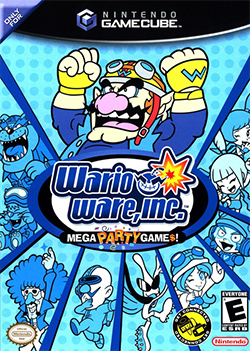
WarioWare, Inc.: Mega Party Game$! is a party video game for the GameCube. A remake of WarioWare, Inc.: Mega Microgames!, and the second installment in the WarioWare series, the game translates the "microgame" gameplay of Mega Microgames! to be playable in a multiplayer environment. It comes with eight special multiplayer modes for up to four players that all involve the known microgames in some way.

Dr. Mario 64 is a tile-matching action puzzle video game developed and published by Nintendo for the Nintendo 64. The game was released in North America on April 9, 2001. The game is an enhanced remake of Dr. Mario, which was originally released for the NES and Game Boy consoles in 1990, and is based around characters from the 2000 Game Boy Color game Wario Land 3. The game's soundtrack was composed by Seiichi Tokunaga, featuring arrangements of classic Dr. Mario tunes and new compositions.

Tetris & Dr. Mario is a 1994 puzzle video game compilation published by Nintendo for the Super Nintendo Entertainment System. It contains enhanced remakes of Tetris (1989) and Dr. Mario (1990), which were originally released for both the Nintendo Entertainment System and Game Boy in North America. Both games include split-screen multiplayer and a "Mixed Match" mode that transitions between the two games.

Mario & Wario is a puzzle video game developed by Game Freak and published by Nintendo for the Super Famicom. It was released exclusively in Japan in 1993. Mario & Wario requires the Super Famicom Mouse accessory to play. Despite being a Japan-only release, the game is entirely in English.

Nintendo Puzzle Collection is a 2003 video game compilation published for the GameCube in Japan by Nintendo. It includes updated versions of three Nintendo-published puzzle video games released for older systems — Yoshi's Cookie (1992), Panel de Pon (1995), and Dr. Mario 64 (2001) — featuring updated graphics and music, alongside four-person multiplayer. The player can download one of the games to their Game Boy Advance via the GameCube – Game Boy Advance link cable.

WarioWare: Smooth Moves is a party video game developed by Nintendo SPD and Intelligent Systems. The game was published by Nintendo for its Wii video game system in Japan in December 2006, and in Europe, North America, and Australia in January 2007. It is the fifth game in the WarioWare series of games, and the only game in the series to be physically released for the Wii. Like its predecessors, WarioWare: Smooth Moves is built around a collection of microgames that last about five seconds each, and which require that the player hold the Wii Remote in specific positions. The game offers the microgames to the player in rapid succession, by first instructing the player to hold the Wii Remote in a specific manner, and then showing them the microgame. The microgames are divided into several stages, each of which loosely connects the microgames with the help of a story. Additionally, this was the first spin-off Mario game to be released for the console.

Tetris is a puzzle video game developed and published by Nintendo for the Game Boy in 1989. It is a portable version of Alexey Pajitnov's original Tetris and it was bundled with the North American and European releases of the Game Boy itself. It is the first game to have been compatible with the Game Link Cable, a pack-in accessory that allows two Game Boy consoles to link for multiplayer purposes. A remaster, Tetris DX, was released on the Game Boy Color in 1998. A Nintendo 3DS Virtual Console version of Tetris was released in December 2011, lacking multiplayer functionality. The game was released on the Nintendo Switch Online service in February 2023.
Hiroji Kiyotake is a game designer for Nintendo and has been a part of the history of Nintendo since 1983.

Mario is a Japanese multimedia franchise created by Japanese game designer Shigeru Miyamoto for video game company Nintendo, which produces and publishes its installments. Starring the titular Italian plumber Mario, it is primarily a video game franchise but has extended to other forms of media, including television series, comic books, a 1993 feature film, a 2023 animated film, and theme park attractions. The series' first installment was 1983's Mario Bros. even though Mario made his first appearance in 1981's arcade game Donkey Kong and had already been featured in several games of the Donkey Kong and Game & Watch series. The Mario games have been developed by a wide variety of developers, including Nintendo, Hudson Soft, and AlphaDream. Mario games have been released almost exclusively for Nintendo's various video game consoles and handhelds, from the third generation onward.

Dr. Luigi is a 2013 puzzle video game developed by Arika and Nintendo SPD, and published by Nintendo for the Wii U console. It is the sixth game in the Dr. Mario series and is part of the larger Mario franchise. The player must clear a field of invading viruses using pill capsules to eliminate them, in a tile-matching fashion. The game offers four modes: "Operation L", which utilizes L-shaped pills; "Virus Buster", using the Wii U GamePad and touchscreen; "Retro Remedy" with standard Dr. Mario gameplay; and local and online multiplayer options, online utilizing the soon to be defunct Nintendo Network Service.

